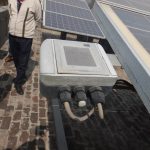Site I.10

Site ID
I.10
Health

COD
2011
Nominal Capacity
60 kWp
Average Specific Yield
730 kWh/kWp
Total Estimated Loss
20.5%
Possible Gain
14% to 19%
CAPEX, OPEX
2.7 ₹/Wp, 1.3 ₹/Wp/a
Expenditure / Energy
N/A
Abstract
The PV plant shows high levels of soiling, inconsistent tilts of the seasonal trackers, severe mechanical damages at the cell level, product defects at the module level and installation failures mainly of the DC cabling. The infrared inspection showed also hotspots induced by cracks and soiling. It is recommended to (i) increase the cleaning frequency to at least three times per month, (ii) homogenize the module tilt, (iii) relocate the shading objects and (iv) conduct a resorting of the modules according to the level of mechanical damage. The estimated production boost caused by the retrofitting actions lies between 14% and 19%.
Main Findings
Heavy soiling caused by bird droppings and the nearby industrial area has been detected.
The PV tables showed inconsistent tilts at the time of the visit. The mounting structure has a seasonal tracking system but the tilt is not kept consistent.
Due to the difficult access to the roof it is likely that the modules suffered mechanical stress during transport, handling and installation. The elelectroluminescense inspection revealed a big number of cracks in the analyzed modules. This was evidenced by the large number of snail trails detected.
Product and installation failures at the module level were detected, such as hot cables at the junction box entry, inaccurate soldering or loose connectors.
Hotspots induced by soiling, near shading and cracks were detected.
The installed irradiation sensor is from a different technology, and has a different tilt angle.
Impact on Performance
Heavy Soiling
Soiling measurements were conducted measuring both the short circuit current and nominal power before and after cleaning at irradiations close to 900 W/m2. The estimated soiling factor is in the range 7– 10%.
Estimated Loss
7%-10%
≈ 8.5%
Cell Cracks
The amount and type of cracks found during the electroluminescense inspection is likely to induce a drop of the nominal power of around 8-10%. Many cracks are evidenced with clearly visible snail trails.
Estimated Loss
8%-10%
≈ 9%
Inhomogeneous tilt angle
The inconsistency of the module tilt leads to a mismatch loss of approximately 3%.
Estimated Loss
≈ 3%
Total Estimated Energy Loss
≈ 20.5%
Proposed Solutions
Spikes against birds shall be installed at the upper edge of the modules.
The cleaning cycles shall be increased and defined based on a soiling study that adjusts the cleaning needs to each season. Cleaning once a month during the dry season is not enough.
The tilt and shading angles throughout the system shall be homogenized.
Modules with heavy cracks shall be grouped in the same string or at least assigned to one MPPT. The grouping will be conducted based on infrared inspection with high irradiation levels and after cleaning.
All modules with faulty connectors shall be replaced.
The lighting pole shall be relocated in order to avoid shadings on the North- West part.
The irradiation sensor should be properly reinstalled and it should be of the same technology as the modules.
Increasing the albedo from 0.2 to 0.5 by covering the ground with white gravel leads to an increase of the irradiation on the tilted surface of at least 1.7%.












